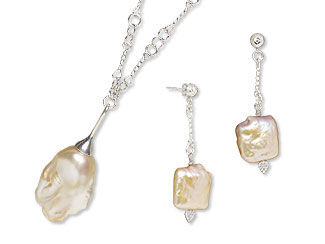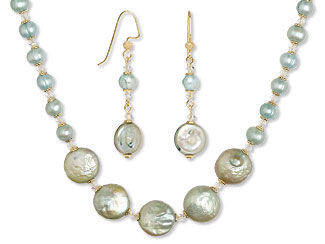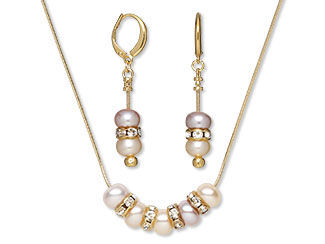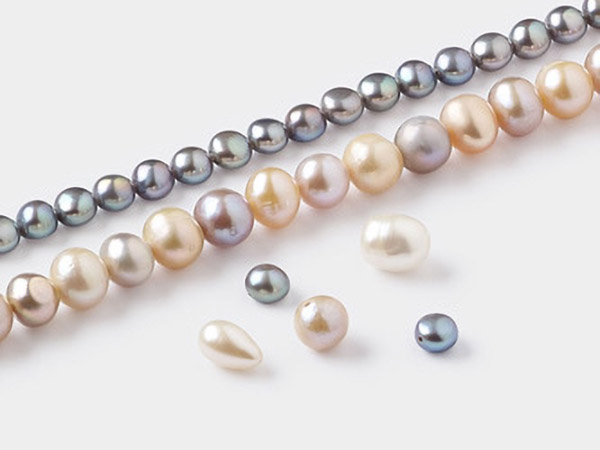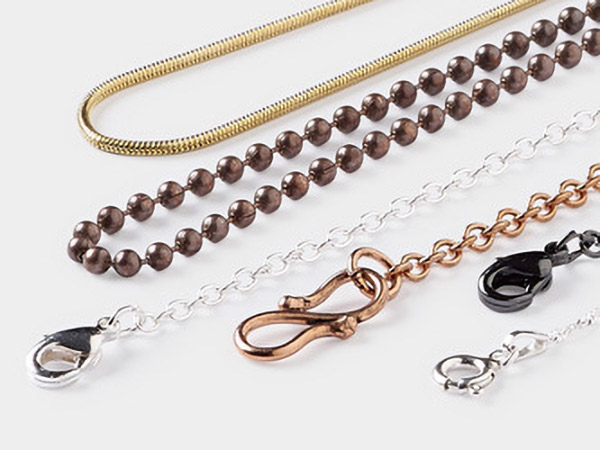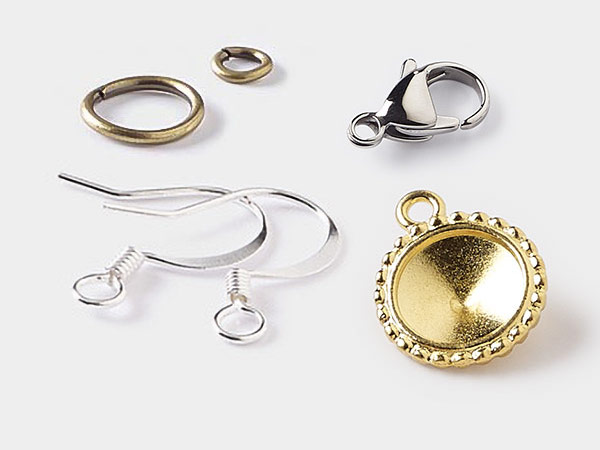The Glorious Pearl: Learn About Pearls Before You Buy
The pearl, with its celestial glow and mystery, is the only gemstone formed within a living creature and throughout history has been a symbol of wealth and sophistication. Ancient Chinese legend tells how the moon holds the power to create pearls, and Arabic lore says that pearls were formed when dewdrops filled with moonlight fell into the ocean and were swallowed by oysters.
In this video and article, you'll learn the difference between natural and cultured freshwater pearls and other popular pearls including Akoya pearls, Tahitian pearls, South Seas pearls, White Lotus™ pearls, saltwater pearls, keshi pearls and more. Learn about pearl grading, pearl enhancement codes, what affects the price of pearls, how to care for natural and cultured freshwater pearl jewelry and how to accessorize with pearls.

Natural vs. Cultured Pearls
A natural pearl begins as a foreign object, such as a piece of sand, caught inside an oyster's inner body. The oyster goes into defensive action and secretes a substance called nacre around this foreign object (irritant) to protect itself. The oyster will continue to secrete nacre around the irritant, adding layer upon layer, to produce a natural pearl.
Natural pearls are extremely rare—In every 10,000 oysters, you might be lucky to find a single natural pearl. Just recently, a double-strand of 68 perfect natural pearls, known as the "Baroda Pearls," was auctioned at Christie's Auction House for $7 million. Because of this scarcity, most pearls today are cultured pearls.
Kokichi Mikimoto patented the process of culturing pearls inside Akoya oysters in Japan in 1916. Once cultured pearls were developed and offered to the public in the 1920s, the "pearl craze" began—everyone wanted them, could afford them and wore them. Because the culturing process occurs over several years, a perfect balance of conditions is required for the aquaculture, or growth in water, of pearls. It takes more than 800,000 oyster hours to grow cultured pearls considered of "high quality."
Japan dominated the industry until China became the leading producer of cultured pearls in the 1980s. Cultured pearls are still actual pearls, sharing the same properties as natural pearls and growing organically inside of oysters in the same fashion as natural pearls. The only difference is a person carefully implants the irritant, a small piece of polished shell, in the oyster, rather than leaving it to chance. However, it's still up to nature to create the miraculous beauty of a pearl.
Cultured pearls can be from saltwater or freshwater mollusks. Freshwater pearls are formed in freshwater mussels that live in lakes, rivers, ponds and other bodies of fresh water. Most freshwater cultured pearls sold today come from China. By contrast, saltwater pearls (such as the Akoya, South Sea and Tahitian pearls) grow in oysters that live in the ocean, usually in protected lagoons.
Crystal and Glass Pearls
Fire Mountain Gems and Beads offers a wide selection of Crystal Passions® pearl beads. These crystal pearl beads in classic organic shapes feature a lustrous surface of “nacre” applied to a solid crystal core. Shop Crystal Passions® pearl beads by size, shape and color, and by color-themed assortments for beautiful jewelry designs. Jewelry designers also depend on Celestial Crystal® glass pearls for an economic alternative to natural pearls.
Tahitian Black Pearls
Tahitian black pearls, also called South Sea Black pearls, are grown in the waters of French Polynesia. They are cultivated from the black-lipped variety of the Pinctada maxima oyster, which reach a foot or more in diameter, producing large pearls. The oyster is very sensitive to the pearl culturing process, which makes the pearls very costly to produce. These dramatic pearls are traditionally called "black," but their color can range from metallic silver to graphite with blue, purple or green overtones.
South Sea Pearls
South Sea pearls, also called White South Sea pearls, are saltwater pearls with a unique, satiny luster that comes from the rapidly deposited nacre and warm waters of the South Seas, located between the northern coast of Australia and southern coast of China. These waters are the native habitat of the large oyster, the Pinctada maxima. The oyster grows up to 12 inches in diameter, and can be nucleated with a much larger bead than other saltwater oysters, such as the Ayoka.
The two different varieties of Pinctada maxima are distinguished by the coloration of the outer edge of the interior: the silver-lipped and the gold-lipped. The shell is known as mother-of-pearl, and is responsible for the coloration of the cultured pearls produced.
South Sea pearls also have a subtle array of colors, typically white, silver and golden, that are rare in other pearl types. The South Sea oyster will only accept one nucleation at a time and because of the rarity and sensitivity of this type of oyster, cultivation of these pearls is much more difficult, making them more expensive.
Freshwater Pearls
Freshwater cultured pearls come from freshwater mussels and appear in a wide variety of shapes and natural colors. They tend to be less expensive than saltwater pearls, making them a popular choice for younger people and jewelry designers. As freshwater pearls are solid nacre, they are also quite durable, resisting chipping, wear and degeneration.
Keshi Pearls
The word keshi means "poppy seed" in Japanese, and these pearls are often referred to as "poppy seed pearls." Keshi pearls are formed when the oyster rejects and spits out the implanted nucleus before the culturing process is completed. Keshi may form in either saltwater or freshwater pearls and they are generally small in size with widely varying shapes because there is no nucleus to guide the process.
Keshi pearls come in myriad of colors, and tend to be high luster. Because the implanted nucleus of the pearl has been expelled by the oyster, the resulting pearl is 100 percent nacre, giving it a lustrous and shimmering surface quality. Even though Keshi pearls are solid nacre, they are not considered natural pearls because they are a byproduct of the culturing process, not a natural occurrence.
Cultured Freshwater Pearl Grading Guide
Different companies have different standards for pearl grading, making it impossible to compare pearls between suppliers based on the letters assigned to them. Fire Mountain Gems and Beads’ pearl grades are those used by the mainland Chinese pearl traders. The Chinese pearl grading standard is as follows:
 |
A Grade: | Extremely well shaped, white, high luster, very minor surface blemishes. |
 |
B Grade: | Well shaped, white to light cream, high luster, minor surface blemishes. |
 |
C Grade: | Irregular shape, off-white, medium luster (may be non-uniform), surface is irregular. |
 |
D Grade: | Same as C grade, but one or more of the characteristics are excessively bad (such as areas of no luster or wrinkled surfaces). |
| F Grade: | For promotional purposes only. Not suitable for jewelry. Most of this grade is ground up into pearl powder (used in cosmetics). |
Some pearls fall between grades and are given mixed grades (A-B grade). Also, a pearl with A grade luster and C grade surface may be given a compromise B grade, though this type of pearl is avoided by Fire Mountain Gems as much as possible.
Pearl Enhancement
As a charter member of the AGTA (American Gem Trade Association), Fire Mountain Gems and Beads abides by AGTA's code of ethics, which is an even higher standard than the Federal Trade Commission's Guides for the Jewelry Industry on disclosing colored gemstone enhancements. Fire Mountain Gems and Beads discloses all enhancements of gems sold (with the exception of normal cutting and polishing) and the method of enhancement, if known.
Pearl Enhancements Codes:
| Symbols for Specific Forms of Enhancements: | |
| Natural (N) | Stones which are not currently known to be enhanced. |
| Bleached | The use of heat, light and/or other agents to lighten or remove a gemstone's color. |
| Dyed | The introduction of color matter onto a pearl to give it new color, intensify present color or improve color uniformity. |
| Irradiated (R) | The use of neutrons, gamma rays or beta particles (high energy electrons) to alter a pearl's color. |
| Symbols for Specific Forms of Enhancements: | |
| Natural (N) | Stones which are not currently known to be enhanced. |
| Bleached | The use of heat, light and/or other agents to lighten or remove a gemstone's color. |
| Dyed | The introduction of color matter onto a pearl to give it new color, intensify present color or improve color uniformity. |
| Irradiated (R) | The use of neutrons, gamma rays or beta particles (high energy electrons) to alter a pearl's color. |
| Code Enhancement Method | ||
| Pearl (Bleached) | B | Bleached to improve color and appearance |
| Pearl (Dyed) | D | Dyed to give rose, blue or golden overtones or a chemical treatment combined with heat (also called electro-coated) to produce grey to black color |
Pearl Care
Produced by a living organism, pearls require special care because they contain calcareous crystals that are sensitive to chemicals and acids. To care for your cultured or natural pearls, avoid using perfume, hairspray, abrasives, solvents, and nail polish removers while wearing them. Avoid lotions and skin care products which contain citrus oils, and always remove pearls before engaging in exercise, as perspiration can also negatively affect the surface. Pearls are soft and should be treated delicately. Store in a soft, protective bag, away from other jewelry.
Like your skin, cultured pearls contain water and may dehydrate and crack if exposed continuously to arid conditions. Pearls should be cleaned and re-strung annually if worn regularly. Human skin oils are one of the best things for pearls. Pearl owners should wear their pearl jewelry often enough to keep them looking lustrous. Do not use ultrasonic cleaners or steamers, instead wipe gently with a soft cloth after each wearing. For more thorough cleanings, use mild soap and water. If knotted, make sure cord is completely dry before wearing.
Pearls: What is Affecting the Price of Elegance?
We are often asked, "What affects the cost of pearls and the resulting resale value of pearls and pearl jewelry?" Here are some of the contributing factors that affect pearl pricing, impacting us, the jewelry-making community and consumers.
Although pearls are cultivated in various countries, the majority sold from Fire Mountain Gems and Beads® are cultured freshwater pearls grown in Southeast China. Maintaining a close relationship with Chinese pearl farmers helps keep us up-to-date on the pearl market, quality, trends and providing our customers with the best value.
The Environment and Supply
There's a direct correlation between a healthy environment and successful pearl production. Pearl-bearing oysters are filter-feeders, obtaining food from microscopic organisms while filtering up to 50 gallons of water in their daily search for nutrients. This act of filter-feeding makes oysters very susceptible to water pollutants and disease.
Even slightly contaminated water can greatly affect pearl production. Often, pearls are grown in ponds to maintain calm surroundings. These ponds offshoot rivers, giving the ability to gently move water nutrients and waste to and from the oysters. Multiple times a day the oysters are examined and, if at all in distress, immediately removed from the water for risk of contaminating neighboring oysters. Limited healthy environments for oysters can affect the supply and pricing of pearls.
Weather
Since these underwater pearl-bearing creatures have adapted over the years to specific locations, they are sensitive to extreme fluctuation in temperature. If a region has an unusually cold winter or hot summer, the oysters suffer. A flash flood, landslide or earthquake can easily damage the water supply to an area, wiping out an entire oyster farm and losing years of labor and product.
Water Supply
Like so many other countries, China is making efforts to rejuvenate and maintain a substantial supply of clean water. Although pearl farms benefit from clean water, their oysters leave behind waste in the ponds. Similar to goldfish in a bowl, if not properly filtered, the area becomes contaminated, hurting the oysters while also polluting neighboring aquifers.
To preserve fresh water, primarily near metropolitan areas, the Chinese government has placed restrictions on areas allowed for pearl farming. Costly filtration systems for wastewater are now also being required. This has caused the farmers to move their pearl operations to rural areas, which becomes very costly and, in turn, affects the consumer.
World Economy
The world's largest recipients of pearls--the United States, Japan, China, India and Russia--all play a dominant role in the evolution of the pearl market with changes in the economy. From stock prices and market shares to the value of global currency, several financial aspects continue to play a part in the overall price of pearls. Similar to gasoline prices, the cost of pearls is rarely a constant number and changes on a frequent and international basis.
Size and Style
Pearl farmers are seeing a growing demand for bigger pearls. As fashion moves toward larger pearls, the cultivating process takes longer and produces smaller amounts of pearls with higher price tags. As larger pearls become the new standard, the availability of the smaller pearls is dwindling since they are not being cultivated.
In addition, the labor for expert pearl drillers has increased, making the smaller pearls increasingly expensive. Natural white lustrous pearls always remain at a premium. Lower grades (from B- to C) are generally dyed or electro-coated in fashion colors. Because these lower grades are more numerous than natural white pearls with good luster, they are less expensive.
What does this mean for beading enthusiasts and jewelry designers? It means that even though no one is immune to increasing prices, the resale value of pearl jewelry will most likely continue to climb, or be affected by these factors. No matter what economists forecast, fashion-sensitive consumers will continue to desire these traditional fashion accessories for their luster and classic charm and remain willing to buy these timeless gems.
How to Accessorize with Pearls
We usually don't equate timeless with trendy, but pearl necklaces are truly a timeless trend. Pearls have been popular throughout history, highly regarded as a prim and proper piece of jewelry—classic and steeped in tradition. Pearl necklaces are fashioned in different lengths, giving us a pearl look for any fashion or occasion. Pearls can be worn by women of all ages, and well-chosen pearl necklaces are a valuable investment because of their elegance, beauty and timeless style.
The must-have, "classic" piece of pearl jewelry—the single-strand pearl necklace—is just the beginning. Pearl necklaces are found in extra-long lengths, multi-strands, chokers and are even being wrapped around the wrist for endless style options. Pearls can be worn with anything from a casual outfit to a wedding gown or formal dress. Pearl jewelry sets are fashionable with coordinating earrings, rings, bracelets and necklaces. Cultured freshwater pearl designs are incorporating semi-precious bead accents, and pearls are dripping from gold or silver chains. Jewelry artists are also designing with colored pearls—creating beautiful tone-on-tone jewelry pieces.
Pearl Necklace Lengths
Pearl necklaces are commonly defined by where they hang when worn around the neck, instead of by their physical measurement. Here’s a guide for pearl necklace lengths and how to accessorize with pearl necklaces.
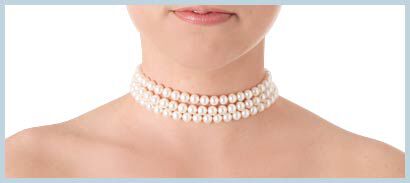
The Pearl Collar - 14 to 17 inches
Three or more strands that fit snugly on the middle of the neck. Accessorize with boat neck, V-neck, or off-the-shoulder fashions.
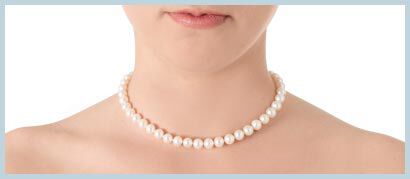
The Pearl Choker - 16 to 18 inches
A versatile pearl choker is appropriate for accessorizing casual to formal eveningwear, and complements almost any neckline.
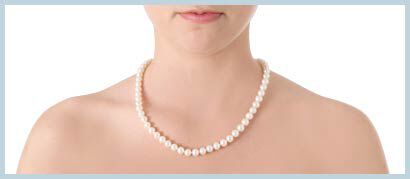
The Princess Necklace - 17 to 19 inches
The most common pearl necklace length, the princess necklace is well suited for crew and high necklines. It also complements low, plunging necklines.
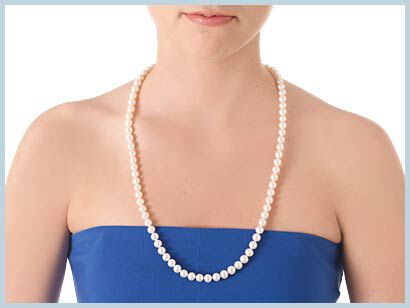
The Matinee Necklace - 20 to 25 inches
A pearl matinee necklace is an ideal choice for casual or business attire. Looks best with high necklines and adds sophistication to a professional look.
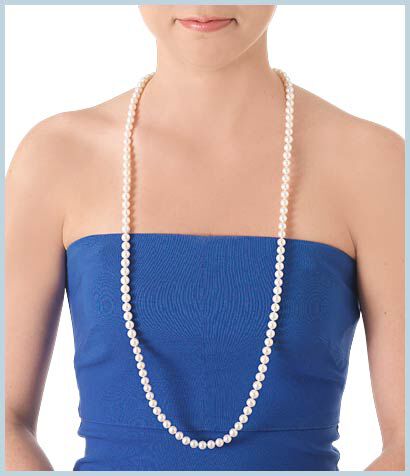
The Opera Necklace - 26 to 36 inches
Worn as a single strand with high necklines or doubled to create a fashionable two-strand choker. Knot at the neckline or above the bust to create a stylish vintage look and accessorize with casual attire for a cutting-edge fashion statement.
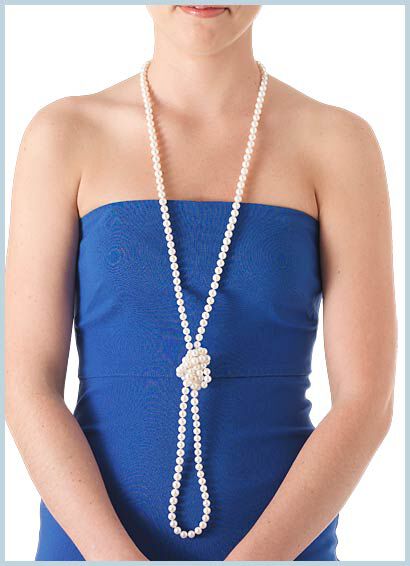
The Pearl Rope - 37 inches or longer
A favorite of Coco Chanel, this luxurious length can be made with several clasps, enabling it to be broken down into different necklace and bracelet combinations, or doubled and even tripled to create a stunning multi-strand choker. Pearl ropes can also be knotted and slung over the shoulder to accentuate the beauty of a backless dress.
Armed with these "pearls of wisdom," you have the power to design and create pearl jewelry that is both timeless and sought-after for all occasions, and appeal to many tastes.
Shop for Your Materials Here:
Have a question regarding this project? Email Customer Service.
Copyright Permissions
All works of authorship (articles, videos, tutorials and other creative works) are from the Fire Mountain Gems and Beads® Collection, and permission to copy is granted for non-commercial educational purposes only. All other reproduction requires written permission. For more information, please email copyrightpermission@firemtn.com.

